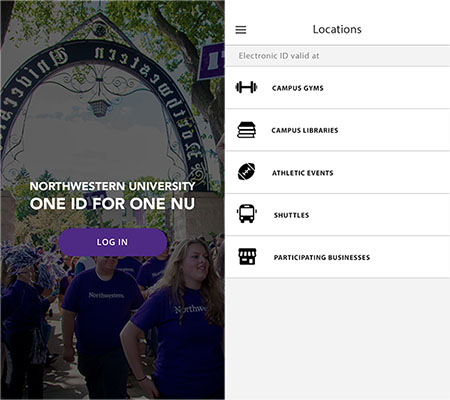Introducing Non-Engineers to Design
Design Thinking and Doing challenges non-engineering student to develop projects that improve Northwestern
For many years, design thinking has been at the cornerstone of Northwestern Engineering’s philosophy and curriculum. But a new class is now proving that design isn’t just for engineers anymore. Now in its second quarter, Design Thinking and Doing (DTD) introduces non-engineers to the design process and is the first course the McCormick School of Engineering has offered solely to students outside the school.

“Design is not just an engineering discipline but a way of thinking,” said Barbara Shwom, writing professor and director of The Writing Place who co-teaches the course.
“It’s a robust problem-solving process,” added Stacy Benjamin, senior lecturer and director of the Segal Design Certificate program who also teaches the course. “So anybody, anywhere can apply it to address different challenges.”
After teaching the Interdisciplinary Design Projects course series together for eight years, Benjamin and Shwom noticed their engineering and non-engineering students demonstrated very different backgrounds, skills, and ways of communicating. Engineers in their classes had already taken McCormick’s popular Design Thinking and Communication (DTC) course, which is required for all first-year engineers. DTC puts students to work on real design problems submitted by individuals, non-profits, entrepreneurs, and industry members. Working in teams, students integrate communication skills and design thinking to correctly frame a problem and iterate solutions.
 While non-engineers are allowed to take DTC, there simply was not enough space to meet the demand, and much of the course is more specific to engineers. The goal of this new course, called Design Thinking and Doing (DTD), is to give non-engineers the same foundation as their engineering classmates. Considering that design thinking applies to many fields, students immediately embraced the idea.
While non-engineers are allowed to take DTC, there simply was not enough space to meet the demand, and much of the course is more specific to engineers. The goal of this new course, called Design Thinking and Doing (DTD), is to give non-engineers the same foundation as their engineering classmates. Considering that design thinking applies to many fields, students immediately embraced the idea.
“In my field, we can use human-centered design in terms of placing an individual in services or programs,” said Natalie Dulin, a senior studying human development and psychological services in the School of Education and Social Policy. “It requires the same type of collaboration and team work as design.”
In the DTD’s first four weeks, students learn key methods of design thinking, such as user observation, interviewing, prototype design, collecting feedback, and iteration. In the remaining six weeks, students work in teams to develop a project that improves some aspect of the Northwestern community.
Students pitch their own projects, which are then voted on by their classmates and narrowed down to four topics. After choosing their topics, teams spent weeks researching, interviewing users, building prototypes, and evaluating feedback from users and stakeholders. This quarter, the resulting projects are:
- NU ID, a prototype of a mobile app that provides a digital supplement to the University WildCard. Equipped with a barcode and identification information, the app can be scanned and used in the same manner as the physical WildCard.
- SweatMatch, a prototype of a mobile app that matches users with workout partners in order to motivate them to exercise.
- NU Park, a prototype of an app that notifies drivers about the parking rules on campus. Using GPS, the app can tell where a car is parked and check for information about no-parking guidelines.
- NU CAPS App, a prototype that informs students about the programs and services offered by Northwestern’s Counseling and Psychological Services. The app can also help the user make appointments and notifies them of workshops and seminars.
 Inspired by her own experience, Allison Sun pitched the WildCard project. “So many times I stop to swipe my WildCard in the dining hall or at the library and realize that I’ve left it back up in my room or in the pocket of another jacket,” said Sun, a sophomore studying computer science in the Weinberg College of Arts and Sciences.
Inspired by her own experience, Allison Sun pitched the WildCard project. “So many times I stop to swipe my WildCard in the dining hall or at the library and realize that I’ve left it back up in my room or in the pocket of another jacket,” said Sun, a sophomore studying computer science in the Weinberg College of Arts and Sciences.
Sun quickly realized that she isn’t alone. Her team discovered that one out of every 15 students forgets their card when visiting SPAC. And the WildCard office issues 2,200 replacement cards per year, which does not include the large number of people who temporarily misplace them.
During the user observation stage, Sun and her teammates noted that it takes the average student 10 to 12 seconds to find their WildCards in their pockets, wallets, and purses, but people typically have their phones right in their hand. This inspired the team to turn the WildCard into a password-protected mobile app. The app also shows other information tied to the WildCard, such as users’ meal plans and what books they have checked out at the library.
Although the mobile app was the team’s final idea, it was not its first and only idea. They originally brainstormed other ways to redesign the WildCard, including replacing it with a fingerprint scanner or resizing it to fit on a keychain. In fact, all four student projects thoroughly evolved over the course of the quarter.
“The design process requires open-ending thinking that’s really powerful,” Shwom said. “I like students to recognize how much their ideas change from the beginning to the end by using this process and recognize how short-circuiting the process does not serve them well. Everybody is under time pressure and wants to zoom to the finish line. Everybody thinks they immediately know the answer to the problem. The course teaches you that you don’t know the answer to the problem. You might not even know the problem. Design changes your perspective.”